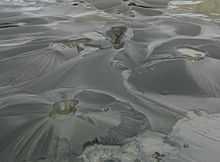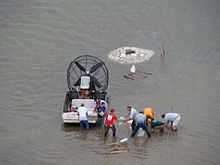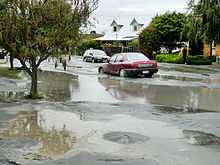Sand boil



Sand boils or sand volcanoes[1] occur when water under pressure wells up through a bed of sand. The water looks like it is "boiling" up from the bed of sand, hence the name.
Flood protection structures
Sand boils can be a mechanism contributing to liquefaction and levee failure during floods. This effect is caused by a difference in pressure on two sides of a levee or dike, most likely during a flood. This process can result in internal erosion, whereby the removal of soil particles results in a pipe through the embankment. The creation of the pipe will quickly pick up pace and will eventually result in failure of the embankment.
A sand boil is difficult to stop. The most effective method is by creating a body of water above the boil to create enough pressure to slow the flow of water. A slower flow will not be able to move soil particles. The body of water is often created with sandbags forming a ring around the boil.[2]
During the flood of spring 2011, the United States Army Corps of Engineers had to work to contain the largest sand boil ever discovered. The sand boil measured 30 feet by 40 feet and was located in the city of Cairo, Illinois at the confluence of the Mississippi River and the Ohio River.[3]
Earthquakes
An example of this is during the 1989 earthquake in San Francisco, when sand boils brought up debris from the 1906 earthquake. This process is a result of liquefaction.
References
- ↑ "Christchurch Earthquake - An Overview". Institution of Professional Engineers New Zealand. March 2011.
- ↑ UC Davis, Department of Civil & Environmental Engineering: Photograph of sandbag ring
- ↑ wpsdlocal6.com
External links
- USGS Visual Glossary: sand boil
- Sand boils along the Mississippi (LSU)
- UC Davis, Department of Civil & Environmental Engineering:Delta Levee Failures